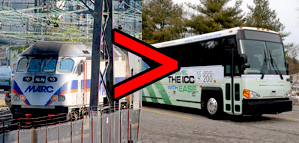|
Special Features





Image Libraries


|
|
Blog
In the latest draft of DDOT’s MoveDC plan, the 37-mile streetcar network originally planned in 2010 becomes a 69-mile “high capacity transit” network.
The new 69-mile network would include DC’s initial 22-mile streetcar system, plus 47 more miles of either streetcar or BRT.
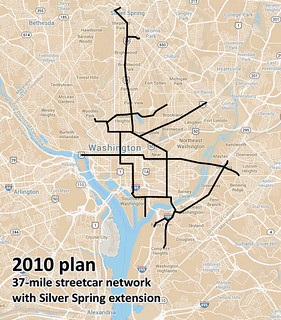 |
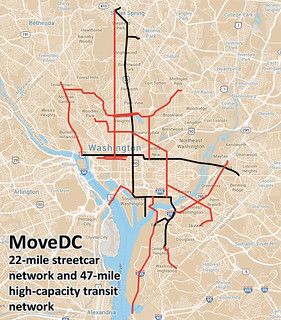 |
| 37-mile network from 2010, and latest MoveDC 69-mile proposal. Base maps from Google. |
The 47-mile network, shown in red on the map, would include 25-miles of dedicated transit lanes, regardless of whether those lines are eventually built as bus or rail. The dedicated lanes would be on 16th Street, North Capitol Street, I-295, M Street SE & SW, and I and H Streets downtown.
Curiously, the proposed streetcar line on Rhode Island Avenue from the 2010 plan isn’t carried forward into MoveDC.
The new plan shows the 14th Street streetcar shifting over to 7th Street, although the details of that line are still in flux. It could still end up on 14th.
Finally, MoveDC also notes several potential extensions to Maryland and Virginia, anywhere a proposed DDOT line approaches the District boundary. Perhaps most notably, there are potential connections across Long Bridge into Arlington, down I-295 to National Harbor, and to Silver Spring.
For Metrorail, MoveDC includes WMATA’s proposal for a new loop subway line through DC, connecting Rosslyn on one end and the Yellow Line bridge on the other.

Map from BeyondDC, using base map from Google.
Overall this is a progressive and ambitious proposal, although the removal of Rhode Island Avenue raises questions. It’s still a draft, so you can comment via the WeMoveDC website.
 Cross-posted at Greater Greater Washington. Cross-posted at Greater Greater Washington.
Average Rating: 4.6 out of 5 based on 155 user reviews.
November 22nd, 2013 | Permalink
Tags: BRT, master planning, streetcar, transportation

I’m in Seattle this week for the Railvolution conference, along with about half of GGW’s editorial team. Since I’ll be too busy geeking out at transit nerd nirvana to blog, each day this week there will be a brief post about some cool transportation-related thing here in Seattle. Today: Their unique bus/rail subway.
The Seattle Transit Tunnel is a 5-station subway that forms the core of Seattle’s transit network. It started off as a bus-only subway, but became a joint bus/rail tunnel when Seattle’s Central Link light rail line opened in 2009.
Each station is different, but one, Pioneer Square, would look particularly at home in DC:
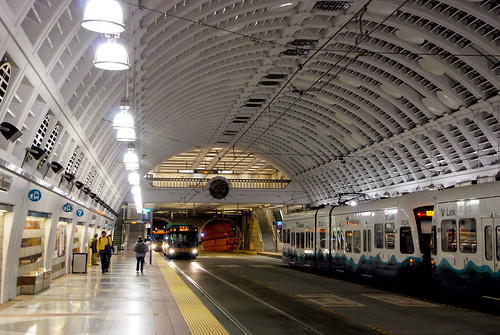
Pioneer Square subway station.
Tomorrow: The famous Monorail.
 Cross-posted at Greater Greater Washington. Cross-posted at Greater Greater Washington.
Average Rating: 5 out of 5 based on 196 user reviews.
October 21st, 2013 | Permalink
Tags: BRT, bus, lightrail, transportation

When the new Rosslyn Metro entrance opened earlier this week, it became the first in what will be an exciting string of big transit projects opening in the DC region. Still to come: Metro, MARC, streetcars, and BRT.

From left to right: Alexandria’s BRT, MARC, Silver Line, DC streetcar.
BRT and Metro photos from Alexandria and Fairfax County.
MARC and streetcar photos from BeyondDC.
The next big event will be on December 7, when MARC trains begin running on weekends between DC and Baltimore. MARC’s transition from a commuter railroad to a more general-purpose transit system will open up Baltimore and other parts of Maryland like never before.
After that come streetcars. Sometime in late December, or possibly January, DDOT expects to start running streetcars along H Street.
Then in February the Silver Line will open, and begin carrying passengers to Tysons Corner and Wiehle Avenue.
Finally, sometime in the spring of 2014 Alexandria will open its Route 1 transitway, marking the beginning of the first bona fide bus rapid transit line in the region.
All together, it’s the most exciting time for transit openings in the DC area since the early 1980s, when Metrorail was opening new segments every few months.
 Cross-posted at Greater Greater Washington. Cross-posted at Greater Greater Washington.
Average Rating: 4.7 out of 5 based on 228 user reviews.
October 9th, 2013 | Permalink
Tags: BRT, commuterrail, metrorail, streetcar, transportation

|

Almost $20 million will go to new VRE railcars. |
For years, leaders in Northern Virginia have been asking Richmond to let Northern Virginia raise its own money to spend on its own transportation priorities. They are finally getting the chance.
When the Virginia General Assembly passed a broad new transportation funding bill earlier this year, it included a section for Northern Virginia to raise and allocate hundreds of millions of dollars per year. Those new taxes began rolling in on July 1, with the beginning of Virginia fiscal year 2014.
On Wednesday night, the Northern Virginia Transportation Authority (NVTA) officially approved its first set of projects. The authority allocated about $210 million, split roughly evenly between transit and roads.
The largest projects include the Silver Line’s Innovation Center Metro station, new VRE railcars, and widenings along Route 28.
NVTA also approved a bond validation lawsuit that will preemptively ask Virginia courts to rule on NVTA’s legality. That process should take 6-9 months, and NVTA will have to wait until it’s over to actually start spending money. Taking the suit to court now means NVTA won’t have to spend years fending off other legal challenges.
The project list is shown below. For more details, see the project description sheets on NVTA’s website.
| Project |
Funding
in millions |
Location |
| Transit and multimodal projects |
| Innovation Center Metro station |
$41 |
Fairfax Co. |
| VRE railcars |
$19.8 |
Regional |
| VRE Lorton station 2nd platform |
$7.9 |
Fairfax Co. |
| WMATA buses |
$7 |
Regional |
| WMATA Orange Line traction power upgrades for 8-car trains |
$5 |
Regional |
| DASH buses |
$3.3 |
Alexandria |
| Potomac Yard Metro station environmental study |
$2 |
Alexandria |
| Crystal City multimodal center bus bays |
$1.5 |
Arlington |
| VRE Gainesville extension planning |
$1.5 |
Regional |
| VRE Alexandria station pedestrian tunnel & platform improvements |
$1.3 |
Alexandria |
| Herndon Metro station access improvements (road, bus, bike/ped) |
$1.1 |
Fairfax Co. |
| ART buses |
$1 |
Arlington |
| Leesburg park and ride |
$1 |
Loudoun |
| Loudoun County Transit buses |
$0.9 |
Loudoun |
| Route 7 Tysons-to-Alexandria transit alternatives analysis (phase 2) |
$0.8 |
Regional |
| Falls Church pedestrian access to transit |
$0.7 |
Falls Church |
| Duke Street transit signal priority |
$0.7 |
Alexandria |
| PRTC bus |
$0.6 |
Prince William |
| Alexandria bus shelters & real-time information |
$0.5 |
Alexandria |
| Van Buren pedestrian bridge |
$0.3 |
Falls Church |
| Falls Church bus shelters |
$0.2 |
Falls Church |
| Road projects |
| Rt 28 – Linton Hall to Fitzwater Dr |
$28 |
Prince William |
| Rt 28 – Dulles to Rt 50 |
$20 |
Fairfax Co. |
| Belmont Ridge Road north of Dulles Greenway |
$20 |
Loudoun |
| Columbia Pike multimodal improvements (roadway, sidewalk, utilities) |
$12 |
Arlington |
| Rt 28 – McLearen to Dulles |
$11.1 |
Fairfax Co. |
| Rt 28 – Loudoun “hot spots” |
$6.4 |
Loudoun |
| Chain Bridge Road widening |
$5 |
Fairfax City |
| Boundary Channel Dr interchange |
$4.3 |
Arlington |
| Rt 1 – Featherstone Rd to Mary’s Way |
$3 |
Prince William |
| Edwards Ferry Rd interchange |
$1 |
Loudoun |
| Herndon Parkway intersection with Van Buren St |
$0.5 |
Fairfax Co. |
| Herndon Parkway intersection with Sterling Rd |
$0.5 |
Fairfax Co. |
 Cross-posted at Greater Greater Washington. Cross-posted at Greater Greater Washington.
Average Rating: 4.5 out of 5 based on 231 user reviews.
July 26th, 2013 | Permalink
Tags: BRT, bus, commuterrail, funding, government, lightrail, metrorail, roads/cars, transportation

Gaithersburg is interested in starting its own local bus network, and will soon begin a feasibility study to consider whether that makes sense.
Gaithersburg has a number of walkable areas, but they’re poorly connected by transit. Most of the bus lines are designed to get riders to Shady Grove Metro station, and they don’t come very often. A new system would be more oriented towards circulation between Gaithersburg’s own nodes.

Unofficial concept of what a Gaithersburg bus might look like. Image and cheesy name by BeyondDC.
The State of Maryland is already planning to build the Corridor Cities Transitway BRT line through Gaithersburg, and Montgomery County is considering a line on Frederick Avenue as part of its BRT network planning, but those projects are still years away from completion. Even when they’re done, Gaithersburg will still need better bus service on other corridors.
One particularly important destination might be Gaithersburg’s historic downtown, which has a MARC station but won’t have stations on either BRT line.
Gaithersburg’s local system could be operated by WMATA as part of Metrobus, or by Montgomery County as part of Ride-On, or it could be something else, like the Bethesda Circulator. The study will presumably look into what would work best.
With its own system, Gaithersburg would have more control over routes and schedules as compared to WMATA or Ride-On. Its own system would also be more recognizable, and could potentially be cheaper to operate. On the other hand, it would be more difficult to set up.
The Metropolitan Washington Transportation Planning Board approved the study at its meeting yesterday, as part of its Transportation / Land Use Connections planning assistance program.
 Cross-posted at Greater Greater Washington. Cross-posted at Greater Greater Washington.
Average Rating: 4.7 out of 5 based on 219 user reviews.
July 18th, 2013 | Permalink
Tags: BRT, bus, transportation

|

Photo from Eric Allix Rogers on flickr. |
In the never ending debate about streetcars versus bus, rider comfort is a point of contention. Streetcar supporters say rail is smoother and more comfortable and therefore appeals to more people. Opponents say that’s overblown or doesn’t matter.
School buses prove it does matter.
The inside of school buses is much less comfortable than the inside of comparatively luxurious transit buses used for BRT. School buses have narrower aisles, and group benches instead of individual seats. They usually don’t have air conditioning. They’re high-floor, and ugly, and definitely uncool.
And although school buses are shorter than articulated buses, you could squeeze through the same capacity if you simply run more of them. That would be easy because school buses are way, way cheaper. A new school bus costs about $75, 000, versus maybe $700, 000 for an articulated transit bus.
Sound familiar?
So instead of attacking streetcars, why aren’t BRT proponents demanding school buses, and calling wasteful any proposal that uses unnecessarily expensive transit buses?
Because ride quality matters, and desirability matters, and because being cool matters if you hope to attract riders who can opt to drive whenever they want.
The arguments streetcar opponents use to denigrate the ride quality benefits of streetcars could be used with equal validity to denigrate BRT, in favor of school buses. But nobody makes that argument, because everyone knows it’s wrong.
If you want anybody other than captive minors to ride transit then you have to shell out for luxurious rider amenities.
Don’t be dogmatic, mind the details
Of course, none of this is a zero sum game. Sometimes school buses are the right solution, even though they stink compared to streetcars and transit buses. Likewise, sometimes BRT is the right solution, and sometimes it’s streetcar.
Even among the modes, it’s not zero sum. Just how much of a ride quality benefit rail provides can vary a lot depending on the specific vehicle and route.
Rail is typically smoother than bus for two reasons: The vehicle is heavier and therefore jostles around less, and gliding along a rail is inherently smoother than rumbling over asphalt. But individual results vary. The US-built Oregon Ironworks streetcar in Portland is reportedly pretty jerky. That’s due partly to a prototype propulsion system that isn’t quite right, but also partly to the fact that it’s one of the smallest and lightest modern streetcars on the market.
DC has 3 of those Oregon Ironworks streetcars on order right now. They’re supposedly improved over the prototype model, but if they aren’t as smooth as the 3 Czech-built streetcars currently being tested in Anacostia then DDOT may want to consider a different vendor for future purchases.
The trick, as with any decision, is to match the needs to the corridor.
For elementary school trips, the benefits of luxurious transit buses aren’t worth their added costs over school buses. For adult commuting trips that compete with cars, it’s worth it to pay more.
And although the benefits of rail aren’t worth the cost trade-offs for probably 90% of the bus routes in the region, there are a dozen or so high-profile corridors where it is worth the expense.
Average Rating: 4.4 out of 5 based on 271 user reviews.
July 1st, 2013 | Permalink
Tags: BRT, bus, streetcar, transportation

|
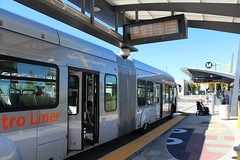
LA Orange Line BRT.
Photo by Matt Johnson. |
LA’s Orange Line is one of America’s most well-planned and successful BRT routes. It’s real BRT, with a dedicated busway and rail-like amenities. And it has a big problem: Just 8 years after opening, it’s hitting maximum capacity.
At rush hour, the Orange Line runs 60′ articulated buses every 4 minutes. That’s already peak efficiency.
More buses would add more seats, but would also disrupt the traffic signals along the line, slowing buses and causing bunching. Capacity would technically go up, but the line would slow down for everyone, and traffic on surrounding streets could get worse.
Even with a dedicated busway, you just can’t run vehicles more often than about every 4 minutes without a lot of negative effects. Not unless you fully separate every single intersection with elevated flyovers.
At some point, the most effective way to increase capacity is with larger vehicles. That means rail. And at about 30, 000 riders per day, LA’s Orange Line is hitting that threshold.
Oh by the way, Arlington’s Columbia Pike corridor is projected to have over 30, 000 transit riders by 2030. And it won’t have a dedicated busway.
Average Rating: 5 out of 5 based on 205 user reviews.
May 21st, 2013 | Permalink
Tags: BRT, streetcar, transportation

There was good news and bad news for Maryland transit yesterday.
The bad news was Maryland’s decision to cut bus service on the ICC. The good news was that the Purple Line, Corridor Cities Transitway, and Baltimore Red Line are all advancing, and that MARC’s Penn Line will start running on the weekend.
Overall, that’s a huge net gain for transit in Maryland.
The new BRT and light rail lines are still years away, but weekend MARC service could start as soon as this winter. The MARC news alone is a bigger win for transit than the ICC buses are a loss.
Not that there’s actually any trade here. MARC isn’t expanding service because ICC buses are going away. The two are unrelated. Just that, as a transit user, if I were given the choice between those two things, I’d definitely pick weekend MARC.
And although Maryland is deservedly criticized for the ICC, it’s also worth noting that the ICC is in the past, and the state’s current plans are extremely progressive.
Most of the new state’s new transportation money is going to transit instead of roads, and most of the road projects are relatively reasonable. There are plenty of proposed interchange improvements and widenings, but there’s no sprawl-inducing, traffic-generating outer beltway.
Average Rating: 4.9 out of 5 based on 203 user reviews.
May 17th, 2013 | Permalink
Tags: BRT, bus, commuterrail, lightrail, roads/cars, transportation

WMATA has settled on a brand for its upcoming Crystal City Potomac Yard BRT line. It will be called Metro Way, and it will feature a flashy new blue paint scheme.

Metro Way. Image from WMATA.
The BRT line will run from Pentagon City through Crystal City and then into Alexandria. It will have dedicated lanes, with large rail-like stations, and will run every 6 minutes during rush hour, and every 12-15 at other times.
In a few years it will be upgraded to streetcar. But in the mean time, it’s the DC region’s first bona fide BRT.
WMATA selected the Metro Way brand and livery following a survey this past March that considered several options. The blue livery, although clearly unique, reflects Metro’s use of blue for its MetroExtra express buses.
 Cross-posted at Greater Greater Washington. Cross-posted at Greater Greater Washington.
Average Rating: 4.4 out of 5 based on 224 user reviews.
May 10th, 2013 | Permalink
Tags: BRT, transportation

Richmond has the bones of a good city. It’s small, with only a million people in its whole metro area, but it has a relatively large downtown and some very high quality urban neighborhoods. What it lacks is a transit system to match. The city’s new transportation plan aims to fix that.
Richmond’s bus system currently carries about 35, 000 riders per day, total, for the whole region. That’s about the same as the Fairfax County Connector, and less than half of the 90, 000 or so that Montgomery County’s Ride-On carries each day. Richmond could get so much more out of transit.
And now, it looks like they’re moving in that direction. The City of Richmond is drafting a new multimodal transportation plan. It builds on existing plans for a BRT line on Broad Street to propose a whole network of priority transit corridors. These would essentially be high quality surface bus routes, like WMATA’s 16th Street line. Not rapid, but not bad.
In addition to Broad Street BRT, the plan calls for 4 other priority bus lines, including one on the important Main Street / Cary Street corridor.

Richmond transit plan.
The draft plan also identifies bike improvements. Richmond is a natural biking city. It’s dense and walkable, and the urban areas are small enough that it’s easy to get to them all with a bike. Among proposed improvements, the plan calls for a bikesharing network, and identifies locations for cycle tracks.

Richmond bike/ped plan.
Right now Richmond doesn’t have enough non-car transportation options. Even though the land use is already there to support multimodalism, most people rely on cars for most trips. Hopefully these proposals become reality, and transportation choice becomes more practical.
 Cross-posted at Greater Greater Washington. Cross-posted at Greater Greater Washington.
Average Rating: 4.5 out of 5 based on 223 user reviews.
April 10th, 2013 | Permalink
Tags: BRT, bus, master planning, transportation

|
Media





Site
About BeyondDC
Archive 2003-06
Contact
Category Tags:
Partners
|



 Cross-posted at Greater Greater Washington.
Cross-posted at Greater Greater Washington.















